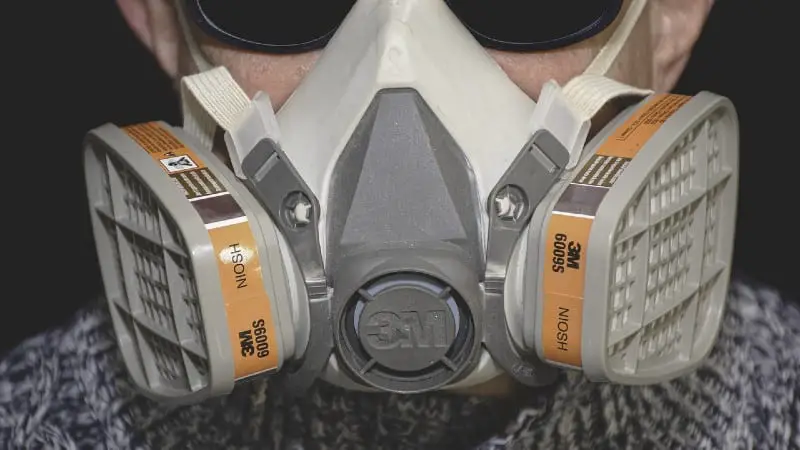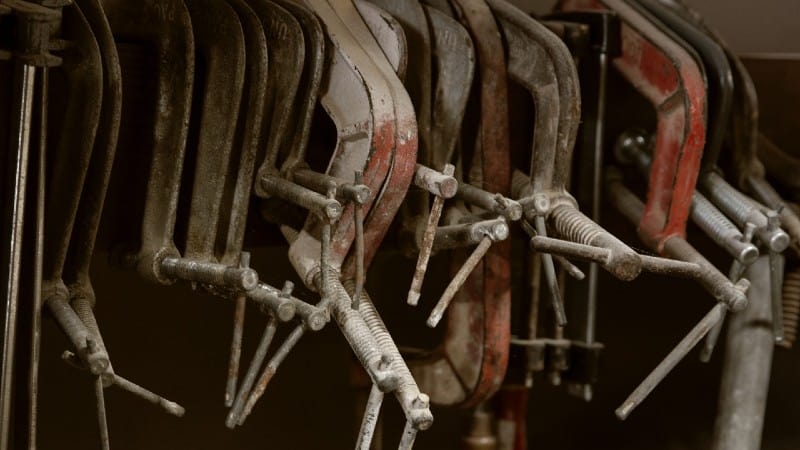There are many tips out there that can help you to become a better woodworker with a jigsaw. My goal is to provide you with the most helpful and straightforward tips for using a jigsaw so that you can become more comfortable with this power tool and improve the accuracy of your cuts. The 31 helpful tips will be written in an outline format so that the information is easily accessible.
#1 – A good jigsaw is one of the most useful tools in a woodworker’s arsenal
A good jigsaw is one of the most useful tools in a woodworker’s arsenal and can be used in a number of ways. It is capable of cutting through hard or soft woods and plastics along straight or curved lines, and can also be used to cut out intricate shapes and patterns.
A jigsaw can cut curves and circles, but it is also great for cutting straight lines in wood (with straightedge guides!). It can even be used to make plunge cuts into wood. A plunge cut is a method of cutting where you start the saw while the blade is not touching the surface of the wood. You then tilt the saw down into the wood and begin your cut. This technique can be used to cut openings for outlet boxes, light switches, etc. into pieces of paneling.
For many woodworkers, the jigsaw is one of the first tools they purchase. And for good reason – this tool can be used to make a variety of cuts in many materials.
Jigsaws are great because:
- They’re easy to use and relatively inexpensive (good starter jigsaws cost between $50 and $100)
- They work well when you need to cut curves into your workpiece
- They work well on many different types of materials, including wood, metal, and plastic
- They’re easy to use and versatile
- There is no need for a table to mount them on – they’re handheld
- They’re inexpensive compared to other saws like circular or table saws
A good jigsaw is one of the most useful tools in a woodworker’s arsenal. There are many different jigsaws available, ranging from the inexpensive variety up to top-of-the-line models that cost over $200. The difference is usually in terms of speed, quality of cut, and ease of use. It is usually worth spending some extra money on a good machine.
Woodworking takes special skills and a lot of patience. The tools that you need to do the job can be quite expensive but it is worth the investment if you are going to use these tools often. You may want to consider making a jigsaw part of your collection of tools.
#2 – The key to making clean cuts is knowing what kind of blade to use
A jigsaw is a versatile tool. It can be used to cut curves and circles, or to make straight cuts in wood. But you can’t just throw any old jigsaw blade into the saw and expect it to do a good job. The key to making clean cuts in wood is knowing what kind of jigsaw blade to use.
Jigsaw blades are typically made of high-carbon steel or bimetal (a combination of high-carbon steel and high-speed steel). High-carbon steel blades are inexpensive and work well on softwoods. Bimetal blades have the benefit of staying sharp longer so they require fewer blade changes and are suitable for cutting harder materials.
Jigsaw blades come in two main types: T-shank and U-shank. T-shank is the most common type on today’s jigsaws. Pop one into your jigsaw by pressing down on a release lever, and sliding it into place.
U-shank blades are designed for older models of jigsaws and use a setscrew to lock the blade in place. Using U-shank blades on modern jigsaws may not provide a secure fit, so check your owner’s manual before attempting to use them with your tool. For more information, see the article I wrote about T and U shank jigsaw blades.
The number of teeth per inch (TPI) of the blade is a good indication of what it’s meant for. A high-TPI blade — such as 18 or 24 TPI — will cut relatively slowly but leave a very smooth edge, with little splintering on the top surface of the material. A low-TPI blade — such as 6 or8 TPI — will cut more quickly but leave more roughness on the edge and often cause splintering on the top surface of the material when cutting wood. I wrote an article about the TPI of jigsaw blades.
With a reverse-tooth blade, the teeth face downward. As a result, the jigsaw pushes away from the workpiece when it is operated. So, the operator needs to push the saw down toward the workpiece. The advantage is that the top side gets a cleaner cut than the bottom. This is usually desirable if the top side will be visible in your project.
Use high-quality blades every time. Using a high-quality blade is essential to getting the best results. A cheap blade will not only give you an inferior cut, but it can also break while you’re working, which could potentially be dangerous.
#3 – Don’t carry anything else while you are holding the jigsaw
In general, if there are any tools in your hand, don’t try to carry anything else until they’re put away. It’s just a matter of common sense. You wouldn’t walk down the street while carrying a knife, because if it dropped and cut someone’s foot off, well that would be unfortunate.
You might be tempted to carry other stuff while you’re holding the jigsaw, like a piece of wood or something else. Don’t do it. If you drop whatever it is, it could damage your jigsaw blade. If it drops on you, it could hurt.
#4 – Avoid getting dust into your eyes, nose, or mouth
Wood dust from your jigsaw is hazardous and can cause cancer. Also, some wood dust may contain harmful chemicals such as arsenic or carcinogens like formaldehyde and urea resins, which can cause skin allergies and respiratory problems. Here are some tips:
Wear a mask or respirator to prevent inhaling the dust particles – Keep your work area clean by vacuuming up any sawdust and splinters before they become a problem.
Wear safety glasses – Be sure to wear safety glasses or goggles to avoid sawdust or other particles from getting into your eyes.
Wear gloves if the wood you are cutting is rough or splintered – Gloves will help protect your hands from the sharp edges of wood that can cut your skin.
Wear hearing protection – Wear hearing protection because jigsaws can be very loud and can cause damage to unprotected ears.
Wear work shoes or boots to avoid slipping – This will help prevent any injuries and help you maintain control of the tool. Also, you should avoid high-heeled shoes for the same reason.
You should not wear loose clothing – Loose clothing can get caught in your tools and cause serious injury.
Tie long hair back when you’re using your jigsaw – When you’re using your jigsaw to cut through some wood, safety should be your main concern. That’s why you should always make sure that your hair is tied back when cutting through wood with a jigsaw. Nothing is more frustrating than having your hair get caught in the jigsaw and having to stop your project to get it out. You don’t want any distractions when working with a power tool.
When you eat, sleep, and work around wood dust day after day, you can be setting yourself up for some pretty serious health risks. That’s because it contains all kinds of things you don’t want to breathe – tiny particles of wood, and chemicals used in finishing/treating wood.

#5 – Mark the cutting line clearly
When cutting wood with the jigsaw, it is important to mark the cutting line clearly. This is important so that you do not have to guess where the cutting line is when you’re cutting. Not having a clear line can lead to an inaccurate cut.
Jigsaws are great for cutting curves, but they can also be invaluable for making long straight cuts. The secret to a good straight cut with a jigsaw is to guide the tool with a straightedge. It acts as a fence so that the blade follows a straight path. Make sure that the blade is on the waste side of your layout line.
#6 – Keep your hands away from the blade
Keep your hands away from the jigsaw blade. This might sound obvious, but it can be easy to get careless and lose track of what the saw is doing.
The jigsaw’s blade is hot, even when the saw is turned off. Avoid touching it, or you may burn your fingers.
#7 – Take care when cutting
It is important that you take care when cutting wood with the jigsaw. The jigsaw is a very versatile tool that can be used for a lot of projects. Whether you’re cutting small pieces or large pieces, you’ll need to take some precautions:
Don’t force the saw – use a steady, even pressure and let the blade do the work.
Watch what you’re doing – Avoid getting distracted. Don’t try to work too fast or you might end up cutting something you didn’t mean to.
Be patient while cutting – Using a jigsaw for woodworking requires patience and practice because it takes a lot of time to cut through the wood. Therefore, don’t rush into it as this may result in mistakes that could damage your project.
Work slowly, work accurately, and work calmly – If you rush things, you might end up making a mistake. If you try to force the tool to go faster than it can handle, then there’s a good chance that something will break – probably, the blade.
#8 – If you get tired, take a break
Using the jigsaw can be tiring work. So, don’t hesitate to take breaks when you need them. If your arms or hands start getting tired, take them off the tool for a few minutes and give them a rest!
Aching muscles are not unusual for woodworkers. It’s important to stretch, rest and hydrate regularly to prevent serious injury or pain. Your body will let you know when to keep going; don’t push yourself past what it can handle.
Stay focused on what you’re doing. Don’t get distracted or start multi-tasking while using a jigsaw; it’s too easy for something to go wrong!

#9 – Use a sharp blade
To maximize your jigsaw’s performance and extend its lifespan, keep the blade sharp and clean. Replace dull blades immediately.
If you notice that you need to push harder on the jigsaw to get it to cut or that it’s not cutting as smoothly or quickly as it usually does, it’s time to change the blade.
#10 – Understand orbital action
Orbital action is present in many jigsaws today. When this option is enabled, the blade moves slightly in an oval shape as it goes up and down. Orbital action is usually indicated by a number on the front of the tool (usually from 0 to 3). A higher orbital setting gives a more aggressive cut; selecting no orbital action will provide you with a cleaner cut.
#11 – Use a jigsaw blade with the correct length
The length of the jigsaw blade should be no less than the thickness of the wood piece. In fact, you should also add an additional amount to the length equal to the distance that the blade travels up and down as it cuts.
#12 – Two sides to every story
When you cut with a jigsaw, only the top of the workpiece is visible. Be careful with the underside of the workpiece. In particular, do not cut through cords, workbenches, or run into materials that you did not intend to cut.
Don’t leave your hand or a body part along the cutting path on the underside.

#13 – Measure first
It’s important to make a cutting line when cutting wood with a jigsaw. This can be accomplished in several ways, depending on the type of wood being cut and the accuracy required. If the cut must be precise, mark a line in pencil on the wood where it will be cut. Use a long ruler to draw a straight line for best results.
You may want to adjust the measurement so that the jigsaw blade is on the waste side of the cutting line.
Also, do not forget to measure twice before marking the cutting line. If possible, it’s better to measure three times.
For quick cuts where accuracy is not essential, no marking is necessary at all. Start cutting along the edge of your wood in a straight line. As long as you go slowly and allow your jigsaw time to make its way through thicker pieces of wood, this method can save time and effort.
#14 – Cut away from your body
Always cut away from yourself when you’re using a jigsaw. If the blade becomes jammed, it could push the jigsaw back towards you. By cutting away from yourself, you’re less likely to sustain an injury.
Be safe. Never stand on a ladder or stepstool, and never rest your hand or foot near the line you’re cutting.
There is a chance that you could hurt yourself with any tool when you don’t know how to use it properly. Learn the proper way to use your tools and then get to work!
#15 – Let the blade do the cutting
Let the jigsaw blade do the cutting when cutting wood. Use minimum force when cutting. When you cut too hard, you add unnecessary stress to the jigsaw and increase the risk of kickback. Also, a dull jigsaw blade increases resistance and requires more pressure.
Cut slowly, especially if you’re cutting thick or hard material. This is especially important with larger blades. Blades can generate a lot of heat during operation so let them cool down.
#16 – Clamp your material before you saw it
When you cut your material with a jigsaw, it’s important to clamp down the wood for safety reasons. Wood that is not clamped down can move around too much. This will make it difficult to cut your material in a straight line.
Make sure that your workpiece does not bow downward, even if clamped. This can lead to blade binding and dangerous kickback.
When you clamp your wood down, you reduce the risk of injury, make fewer mistakes, and ensure smooth, accurate cuts. If it moves during a cut, the blade could get pinched which could cause kickback.
Make sure to use clamps that won’t damage the workpiece; if a clamp leaves a dent in the material, use blocks of scrap wood to place between the clamp and workpiece.

#17 – Cut slightly outside the cutting line
The jigsaw should cut on the waste side of the line (on the scrap wood side). Sand or trim the edge for an exact fit. When cutting curves or shapes out of solid stock or sheet goods you’ll want to leave at least about 1/8″ margin between the blade and the pencil line.
You don’t want to cut pieces too small with the jigsaw. You can always sand them down to the proper size after you’ve completed the cut.
#18 – Make plunge cuts carefully
Jigsaw plunge cutting is an important skill that allows you to cut the interior of a piece of wood without needing to start the cut on the edge.
In order to make a plunge cut, you have to first tilt your jigsaw up from the front of the base so that the blade is parallel to the workpiece. You then slowly tilt the saw downward so that the blade starts cutting an opening in the wood.
The blade must be made for plunge cuts and have a pointed tip, or it could break when you attempt the cut.
#19 – Set up in a well-lit workspace
You don’t want to work in the shadows when cutting wood with the jigsaw. It’s important that you can see everything clearly. A well-lit workspace will make it easier to see your project.
This is the easiest tip to follow but the most important: Make sure that you’re in a well-lit area where there are no distractions from your environment.
It’s dangerous to work in the dark, particularly with power tools. So, be sure your jigsaw is in a well-lighted workshop and make sure all electrical cords are properly grounded and secure.
The accuracy of your cuts with the jigsaw depends on being able to see clearly. Don’t use your jigsaw in a dark environment. The best light is natural light if you can, but this isn’t always possible.
Also, it’s more fun to be able to see what you’re doing when cutting wood with the jigsaw!
#20 – Do the job you intended to do
Cutting wood with a jigsaw can be tricky. You want to do the job you intended to do when cutting wood with the jigsaw. You should resist the temptation to exercise too much creativity and stick to measurements and plans that you already made. This will prevent frustration, wasted time, and wasted wood.
Be patient and don’t hurry. Making mistakes when cutting wood with a jigsaw takes a lot longer than doing things right the first time.

#21 – Make sure you have a place to store your blades when not in use
You need to have a place to store your blades when they’re not being used. You can lose them quite easily if you don’t have a place to put them and they aren’t stored properly.
Move your sawdust and stacks of wood out of the way, because it’s important to be organized when cutting wood with a jigsaw!
#22 – Make sure the base of the saw is locked in place before a cut
Make sure the base of the saw is locked in place before cutting. If the jigsaw base is not locked into position, the bevel angle of the cut can change as you operate the jigsaw. This can lead to an inaccurate cut or even reduce your control over the saw.
#23 – Always buy more blades than you think you’ll need
You never know when your jigsaw blade will break, so why not pick up another?
It’s a nightmare to have your blade break during a project, and not have another one on hand. Your time is a valuable resource, so don’t waste it by running to the hardware store.
#24 – Have a stable work surface
You don’t want support for the piece you are cutting with the jigsaw to give out during the middle of the cut, or you can lose control of your saw and it can be thrown toward you, leading to a dangerous situation.
Also, the blade can bind in wood leading to possible kickback.

#25 – Don’t get frustrated when cutting wood with a jigsaw
It takes patience to cut curves properly. Don’t let this discourage you from trying again and again until you get the results you desire. Since you’re cutting into the wood, it’s important to plan out your cuts as best as possible to avoid any waste or miscuts.
But even when you do, there’s always a chance of messing up. You’ve got a million other things on your mind and it’s easy to lose track of just how fast or slow you’re going, how much pressure you’re applying, etc.
You’ll get the hang of it with time but don’t get frustrated if it doesn’t go well at first.
#26 – Don’t cut anything above your eye level
This is a safety tip more than anything else. You want to be able to see what you’re cutting for safety reasons. If you try cutting something too high up, you might not have enough control over your cuts and could hurt yourself or damage your jigsaw blade.
If you lose control when cutting wood with your jigsaw, the blade could break and cause injury. Always keep firm control of the jigsaw, use a blade designed for the material you’re cutting, and don’t get it too hot by forcing it through the wood. If you do lose control and the blade breaks, clean up any broken pieces before using the jigsaw again.
#27 – Remove any debris from your work area before starting to cut
Before you start cutting wood with your jigsaw, carefully remove all debris from the area around where you’ll be working. This includes small pieces of wood, nails, screws, and other metal objects.
If you step on these items while cutting wood with the jigsaw, they can cause you to slip and hurt yourself. The saw blade can also become dull quickly if it comes into contact with these items.
The above tip is especially important if you’re cutting wood on a work table that’s used for other tasks. Make sure there’s nothing on or under the table that can get in your way.
#28 – Know your jigsaw’s limits
Before you take on any cutting job, you’ll want to understand this tool’s strengths and weaknesses. When you do, your cutting jobs will become faster and easier.
When you’re working with the jigsaw, don’t try cutting wood too thick. The thicker the wood, the more difficult it will be to make your cut. If the cut is not exact, you’ll have to sand it. This can take a lot of time and it is not always an easy process.
There’s a right tool for every job. The circular saw might be better suited to making straight cuts in wood than a jigsaw. Choose the proper tools and you’ll finish up your projects with ease.
The jigsaw has limitations and capabilities that you should be aware of before taking on any cutting job. The good news is that understanding this tool’s strengths and weaknesses will help make your cutting jobs faster and easier.

#29 – Practice with scrap wood
When cutting wood with a jigsaw, it is always best to practice on scrap wood. This will allow you to get a feel for the machine and how it cuts. Also, if you make any mistakes, they won’t affect your project.
This will allow you to get a better idea of the amount of time that it will take you to cut through the wood, as well as how much pressure you need to apply to the jigsaw.
This is a great tip, especially if you’re not totally comfortable with the power tools you’re using. It’s easy to get excited and rush into a project and make mistakes but it’s better to be safe than sorry.
Remember that practice makes perfect, so keep practicing until your cuts are smooth and clean.
#30 – Always turn off an electric jigsaw when leaving it unattended
This is an easy step to forget, but it could be very costly if you don’t do it. Remembering to unplug your jigsaw every time before changing a blade can save you from accidentally hurting yourself or damaging your jigsaw.
Also, never take a rest while the saw is plugged in. It’s dangerous to leave the power on while you take a five-minute break — you never know when someone else will come by and inadvertently turn on your jigsaw.
With cordless models, it is a good idea to remove the battery pack, for the same reason.
#31 – The jigsaw blade is hot after cutting
The jigsaw blade is hot after cutting. This is true even after the saw is turned off.
Why is this? The saw blade is very hot because it rubs against the wood as it cuts. This causes friction and heat.
Wait for the blade to cool before touching it. If you must touch it immediately, use a heat-resistant glove or similar material to avoid burning your finger.
Some of the newer jigsaws with T-shank blades provide a quick-release blade mechanism. You don’t even need to touch the blade in order to remove it. A quick-release mechanism is used to “pop the blade out”.
For more information, see another article I wrote called: What is a Jigsaw?
Conclusion
A jigsaw is a great tool for woodworking, but there are many things you can do to improve the experience of using it. We hope that this article has inspired you to bring some of these tips into your own woodworking routine. You’ll be glad you did!
Did you enjoy this article? If so, you might be interested in my Pinterest profile. It contains pins about Woodworking, DIY&Crafts, Tools, Projects, and related topics.


